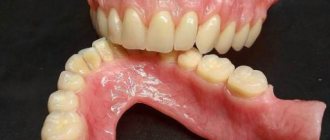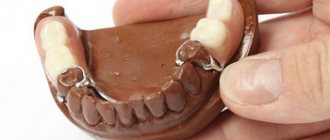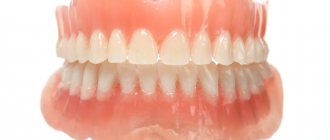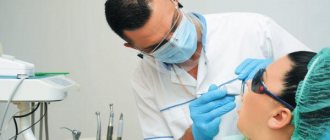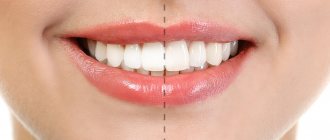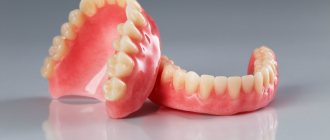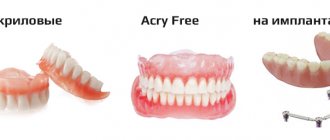Removable dentures - what are they?
Removable dentures are devices that partially or completely replace lost teeth. A distinctive feature of removable structures is the ability for the patient to remove and put them on independently. This feature unites all types of removable dentures with a significant variety of types and models.
Despite the advantages of modern fixed prosthetics, removable dentures also have their advantages:
- relatively low price;
- ease of manufacture and operation of the orthopedist;
- the ability to choose a manufacturing material that is suitable in price and quality;
- the ability to restore any defect in the dentition;
- lightness of the prosthesis, the ability to choose the desired shade of material;
- no need to prepare healthy teeth for prosthetics;
- the ability to repair a damaged model in a dental laboratory;
- ease of care.
Removable dentures solve the problem of restoring the aesthetic and chewing function of teeth when they are lost and it is impossible to establish a fixed model, and therefore increase the quality of human life.
Stages of service provision
The service is provided by appointment.
The installation steps are almost the same as when installing all metal-ceramic structures:
- Examination of the patient, treatment and preparation of teeth for installation of crowns.
- Grinding of teeth, taking an impression and making a temporary structure.
- Manufacturing and installation of permanent crowns.
Typically, all manufacturing and installation work takes no more than 10-12 days and occurs in 2-3 visits
Indications for removable prosthetics
Removable dentures are installed when:
- the absence of several teeth in the dentition and the impossibility of fixed prosthetics;
- the patient’s refusal of fixed prosthetics;
- complete loss of teeth - adentia;
- loss of a large number of teeth (immediate denture);
- loss of one tooth (aesthetic prosthesis);
- for infectious-inflammatory and degenerative-dystrophic diseases of periodontal tissues (periodontitis or periodontal disease);
- severe general diseases that are contraindications for fixed prosthetics;
- individual intolerance to metal structures.
Removable dentures will be an ideal option if you lose several lateral teeth in a row on both sides or if you lose central teeth while keeping the lateral ones. This type of prosthetics is also very suitable for edentulous patients, if the patient refuses implantation.
When does a doctor recommend installing a crown on your teeth?
If the chewing tooth is destroyed, but the dentist does not see the need for removal, then, depending on the degree of destruction, the doctor uses fillings or crowns to restore it.
A problematic back tooth cannot be restored or two or three adjacent units are missing - in the first case, the orthopedist removes the tooth and immediately implants an implant in its place, followed by installing a crown on it.
In the second case, the doctor recommends restoring the chewing teeth using a permanent prosthesis - a bridge with crowns, which is attached to adjacent supporting teeth.
Disadvantages of removable prosthetics
Despite the simplicity and ease of installation of removable dentures, these designs have more disadvantages than advantages:
- the inability to create a uniform load on the jaw tissue, which gradually leads to their atrophy (decrease in volume) and the need to change the model (limited validity period);
- insufficiently reliable fixation in the oral cavity, which often creates problems when chewing and unclear speech;
- difficult process of getting used to wearing; some sensitive people cannot get used to a foreign object in the oral cavity due to injury to soft tissues;
- It is impossible to carry out prosthetics immediately after tooth extraction, as is the case with one-stage implantation.
Removable dentures should be installed only when there are no other prosthetic options, since there are contraindications for installing bridges or prosthetics on implants.
Metal crowns
These are the predecessors of all other types of dentures. This type of prosthesis is indicated for installation only on chewing teeth, since the structures are noticeable on the front teeth. Metal crowns are made of steel, titanium, platinum, and gold. Alloys containing cobalt, chromium, and silver are also in demand.
In laboratory conditions, stamped or cast products with spraying are prepared for patients. Standard structures take on the desired shape as work progresses. Individual production of the cap guarantees maximum adherence to the tissues, which eliminates rapid abrasion of the material and the spread of bacteria under the prosthesis.
Among the advantages of such products, it is worth noting their exceptional strength (due to the plasticity of the material, a crown made of this type of material does not crack and does not wear out for a long time). However, metal dentures are extremely unaesthetic, can cause allergies, and are difficult to fit on a tooth.
In addition, when using metal prosthetics, it is worth considering that crowns made from several types of metal cannot be used at once. If the patient already has a steel structure in his mouth, in the future he will have to fix crowns only from this material. Otherwise, the patient may develop galvanic syndrome, which is manifested by a burning sensation in the mouth and a “metallic” taste.
Types of removable prosthetics
Features of dental prosthetics with removable dentures largely depend on the type of structure, material of manufacture, and method of fixation in the oral cavity.
By type of design
There are two types of models: plate and clasp.
Plate removable dentures
Lamellar (lamellar) are the very first models. Their design is very simple, it consists of a base - plastic, repeating the relief of the gums and palate and artificial crowns installed on them. Constructions of this type are divided into:
Complete and partially removable plate dentures
- complete removable dentures – in case of complete absence of teeth;
- partially removable dentures – if some of the teeth are preserved; one of the modern options is sandwich dentures that do not cover the palate;
- immediate dentures (butterflies, micro dentures) – for 1 – 2 adjacent teeth.
Installation of these models in the oral cavity is easy: the orthopedist makes an impression of the jaw, a model is made from it in a dental laboratory, the orthopedist first tries it on, then installs it. The patient fixes the model by clenching his teeth. Partially removable models are fixed on the preserved teeth using special clasps. After which the patient begins to gradually get used to the new design. Caring for the plate model is quite complicated; it is carried out daily by the patient himself and professional cleaning is carried out twice a year.
- Pros: lightweight, easy to install prosthesis.
- Cons: you have to change it often (at least once every 3 years, sometimes more often), the fixation is unreliable.
Clasp removable dentures
Clasp dentures are modern partially removable dentures, consisting of a plastic base with artificial crowns installed on it, an arched metal frame and hook-clasps fixing the structure on the supporting teeth. A metal arch (clasp) allows you to create the desired load on the jaw tissue. A modern option is the metal-free Quadrotti clasp, where all parts are made of high-strength plastic.
Conventional clasp prosthesis
Metal-free Quadrotti
Installation is more difficult, since it is necessary to prepare the supporting teeth. Caring for the clasp does not require any special skills; it is enough to do it regularly.
- Pros: proper distribution of the load on the jaw prevents bone tissue atrophy, so the structure can last a long time (at least 5 years, but more often much longer), there is no massive plastic base that disrupts taste, lightness and beautiful appearance, reliable fixation in the oral cavity.
- Cons: requires getting used to, sometimes the fixing elements are visible when you smile, high cost.
By fixation method
A full plate removable denture is attached to the oral cavity as follows:
- by removing air between the orthopedic structure and the tissues in the oral cavity while clenching the jaws; this design is called “suction cup”; good fixation is achieved only if all the bends of the structure fully correspond to the bends of the patient’s oral tissues;
- using special fixing adhesives and creams, strips and gaskets.
A partially removable denture is fixed on the supporting teeth using hooks (clasps). Clasp removable dentures are fixed in different ways. According to this principle, all clasp partial removable dentures are divided into the following designs:
Clasps on clasps, attachments and telescopic crowns
- on clasps - hooks securely fix the model on the supporting teeth, but can be noticeable when smiling;
- on attachment locks - complex locks are fixed on supporting teeth covered with crowns, so they are practically invisible; the design is complex to manufacture and therefore expensive;
- on telescopic (retractable) crowns - the most difficult manufacturing option, requiring grinding of the supporting teeth and installing crowns on them.
Conditionally removable models on implants are screwed to titanium roots installed during implantation. They can be removed by the dentist during medical examinations for cleaning. The patient cannot remove them on his own, which is why they are called conditionally removable.
By material
The very first models were made from rubber. Today, plate structures are made from various types of plastics. Certain requirements have been developed for plastic dental materials. They should be:
- durable, able to withstand chewing loads;
- securely connecting to artificial crowns;
- not deformed during wearing;
- non-irritating to periodontal tissues;
- without toxic or allergic effects.
The following materials meet these requirements (partially or fully):
Acrylic removable dentures for teeth
Acrylic is a type of plastic that has replaced rubber in the manufacture of removable dentures. It became widespread in the late 30s of the last century. It causes allergies due to the component contained in the coloring substance, but acrylic without color is also available, which is less aesthetically pleasing, but does not cause allergies.
- Pros: an acrylic prosthesis has a number of advantages compared to a rubber one: it is more durable, aesthetically pleasing, and it is easy to make an inexpensive removable model from it.
- Disadvantages: the material is not elastic enough and during the process of getting used to it often causes tissue irritation;
- during the entire time of wearing, it releases a non-protein substance (monomer), which combines with tissue proteins and causes toxic-allergic reactions;
- The high porosity of acrylic contributes to the accumulation of bacteria on its surface and the development of infectious and inflammatory processes in the oral cavity.
Nylon Removable Dentures
Nylon - removable models began to be made from this type of plastic in the mid-80s of the last century.
Pros - nylon prostheses are more plastic, do not have pronounced porosity, are non-toxic, and hypoallergenic.
Minuses:
- excessive flexibility creates problems in the form of uneven distribution of load and gradual atrophy of the jaw bone tissue;
- the device is not always securely held in the oral cavity.
Acry-Free dentures
Acry-Free (acrylic-free plastic) is a modern thermoplastic material that does not contain acrylic.
- Pros: hypoallergenic, durable, elastic, fits perfectly to the tissues in the oral cavity, is smooth (bacteria do not linger on it), does not irritate the tissue, structures made from it can look like natural ones.
- The downside is the higher cost.
The following materials are used for the manufacture of clasp models:
- Plastic - for the manufacture of the base, mainly high-strength types of plastic manufactured using high technology are used. From these types of plastic it is also possible to make a completely metal-free clasp dental prosthesis Quadrotti. The most famous materials: acetal (acetate plastic) - a modern plastic that has increased resistance to stress, while not causing allergic reactions and tissue irritation; has a wide selection of color shades, very aesthetic; minus – high cost;
- Dental D (white plastic) – an even more durable, elastic material with excellent aesthetic qualities; minus - expensive.
Permanent prosthesis on 4 implants – types and prices
We have already said above that 90% of all permanent fixed dentures on 4 implants are titanium-polymer dentures. They are made on the basis of a milled titanium beam, which will be lined on the outside with acrylic plastic or ceramic composite (this is a mixture of acrylic plastic and ceramic microparticles). Now we will look at the pros and cons of each type of prosthesis.
1) Acrylic prostheses with titanium bar –
A permanent fixed denture on 4 implants, made on a Nobel-Procera titanium bar, where artificial teeth and the base of the prosthesis will be made of acrylic plastic, will cost 370,000 rubles. The warranty for such a prosthesis is usually about 5 years, and its service life is more than 10 years. If a non-original titanium beam is used in the manufacture of the prosthesis, the price will be lower - from about 300,000 rubles. Photo of prostheses (Fig. 21-22).
2) Ceramic composite prostheses with a titanium bar –
This version of the prosthesis is similar to the previous one, but instead of acrylic plastic, a ceramic composite will be used, from which both artificial gums and artificial teeth will be made. If the prosthesis is made on the original Nobel Procera titanium beam, then its cost will be from 400,000 rubles. If a non-original titanium beam is used - about 340,000 rubles. The warranty for such a prosthesis is usually 5 years, the service life is more than 10 years.
It should be noted that, in fact, the service life of a titanium beam is lifelong, because it is almost impossible to break it. However, artificial teeth made of acrylic plastic or ceramic composite tend to gradually wear out, which will require reinstallation of artificial teeth in the prosthesis (replacing old artificial teeth with new ones is carried out on average once every 7 years).
Titanium-polymer prostheses –
Inexpensive alternative to titanium bar dentures:
Some clinics offer the following economical option for a permanent prosthesis. As a supporting frame, not a milled titanium beam will be used, but a beam made by casting from a nickel-chrome alloy. The artificial teeth and artificial pink gum will be made from acrylic plastic. For this option of a permanent denture on 4 implants, the price will be only from 180,000 to 200,000 rubles. If instead of acrylic plastic a ceramic composite is used - from 200,000 to 230,000 rubles.
The warranty on such prostheses is no more than two years, and their service life will be no more than 4-5 years. In no case should this type of prosthesis be made for patients with large jaws and well-defined masticatory muscles, patients with bruxism, and indeed all men under 50 years of age. The frame of such dentures has 5 times less strength (compared to titanium), and simply cannot withstand the chewing load and will burst. In addition, cast frames have a poor fit on the implants, which will mean a higher risk of developing inflammation around the implants.
3) Metal-ceramic bridge prosthesis –
This is a prosthesis option that is better not to do. The original version of such a bridge is made on a milled titanium frame, but it is worth saying that ceramics and titanium are far from the best combination of materials. Titanium gives the ceramics a gray tint, which greatly worsens the aesthetics of the prosthesis (anodizing the titanium frame can more or less solve this problem). Additionally, ceramics on a titanium framework have a higher risk of chipping, and dental technicians generally hate working with this combination of materials.
Another disadvantage of this version of the prosthesis is its very high price, and it will be cheaper to make a bridge from zirconium dioxide. However, there are situations when we can only make this version of the prosthesis. For example, when we need long side consoles for a prosthesis, and at the same time we do not have the opportunity to make a prosthesis on a titanium bar (due to lack of vertical space for prosthetics). But especially for Russia, there is a cheaper option for a metal-ceramic bridge with 4 implants.
In this case, the frame will be made by milling, but not from titanium, but from a cobalt-chromium alloy (CHS). Everything about this prosthesis is good, except for its weight and the presence of overhanging consoles in the prosthesis. The All-on-4 technique implies that the implants will be installed in the teeth position 5-2|2-5, which automatically means that the 6th teeth in the prosthesis are made in the form of overhanging consoles. When such consoles are made not of titanium, but of CHS, they are extremely unreliable and, accordingly, we have a high risk that their CHS frame may burst.
4) Zirconium dioxide bridge –
Of course, this is the most beautiful option for a permanent prosthesis on 4 implants. In this case, the milled frame of the bridge will be made of zirconium dioxide. The original frame is again “Nobel Procera”, but non-original “Prettau” types can also be used. Artificial teeth will also be made of zirconium dioxide using the milling method. The cost of such a prosthesis will be no less than 500,000 rubles. If the artificial teeth in such a prosthesis are made not from zirconium, but from Emax glass ceramics, then the cost will be no less than 550,000 rubles.
All-on-4 bridge made of Prettau ceramics –
The warranty on zirconia bridges is usually up to 10 years, but all ceramic bridges are certainly very expensive. The only more or less inexpensive option for metal-free ceramics is bridge-like prostheses using the Trinia technology (the frame of such prostheses is made of durable fiberglass, and the outside will already be lined with ceramic mass). The cost of the Trinia bridge will be about 250,000 rubles.
Important: if you decide to choose a bridge made of zirconium dioxide, then there are several nuances in the manufacture of the bridge that are important for the patient. It is important how exactly the artificial zirconium crowns will be made. Firstly, they can be made single, and secondly, they can be made in blocks (when several crowns are milled as a single unit). The second option is the best, and in this case the crowns are made in blocks - a block of 6 front teeth + two blocks, including 3 side teeth. Why is this so important?
The fact is that the first option involves many “seams” between the crowns, where pigments and, over time, bacteria will settle (the latter will lead in the distant future to the appearance of an odor from the prosthesis). But when we make artificial crowns in blocks, we have only 2 seams and, accordingly, we solve these problems. By the way, for the same reason, we do not recommend that you make a zirconium bridge in combination with Emax crowns, even if such prostheses have amazing aesthetics.
The fact is that Emax glass-ceramic crowns are made only single (they cannot be milled in the form of blocks with several crowns in each). And, accordingly, such a prosthesis will inevitably darken over time in the area of the seams between the artificial teeth, and an unpleasant odor will also appear. Therefore, the optimal manufacturing option is to use a zirconium dioxide frame in combination with zirconium crowns made in three blocks.
The best removable dentures
After the examination, the orthopedic dentist advises the patient which removable dentures to choose. It is worth listening to these recommendations, since all types of prosthetics have their own indications and contraindications.
Removable dentures for complete absence of teeth
If the patient is completely missing all the teeth in the dentition, then the best option would be conditionally removable prosthetics on implants - all on 4 or all on 6. 4 or 6 titanium roots are implanted into the jaw, after which a model is screwed onto them, completely replicating the anatomy of the jaw. Such teeth are practically no different from natural ones. They do not require daily removal for cleaning; regular oral care and professional cleaning of the model every six months are sufficient. The only disadvantage of conditionally removable prosthetics is its relatively high cost.
If full implantation is not affordable, you can also install a complete removable denture with suction cups. To do this, on the advice of a doctor, you need to select the most suitable plastic for making the model, carefully take an impression so that all the anatomical features of the jaw and oral tissues are fully reflected in the future design. Then, when the jaws are clenched, air is displaced, the structure collapses with the tissues, sticks to them and provides fixation. This type of design can be taken off and put on daily.
To install a removable denture in the absence of teeth, it is not recommended to use nylon structures, since they cannot fully support the chewing function and do not prevent atrophy of the jaw bone tissue.
With partial absence of teeth
The question of which removable dentures are better for incomplete edentia is also decided by the doctor. The best option would be the metal-free clasp Quadrotti model. This is a unique design, very reliable, correctly regulating the load on the tissue. The only negative is the high cost.
Option number two is a regular clasp model using metal. The clasp is also reliable, aesthetically pleasing and does not cause any discomfort when worn. The downside is that it's also not cheap.
A budget option is a plate model made of acrylic. It is also reliable, but not durable and often causes toxic-allergic reactions. To avoid allergies, you can install a colorless acrylic structure, which does not have an entirely aesthetic appearance. If 1–2 teeth are missing, then a butterfly microprosthesis made from any type of plastic can be installed.
Which removable denture is best for the upper and lower jaw?
Any option is suitable for the upper jaw, since there is a significant space behind the back surface of the teeth that allows removable dentures of any type to be securely fixed. But it is still better to give preference to conditionally removable prosthetics on implants. A removable denture for the upper jaw can also be a clasp denture.
Prosthetics on the lower jaw are more problematic; there is no necessary space for fixation, therefore, deciding which removable dentures are better should be entrusted to an orthopedist. The options to choose from are conditionally removable prosthetics on implants and any type of clasp.
Zirconium dioxide crowns
Zirconium crowns are prepared in laboratory conditions using high-precision computer equipment. Laser scanning allows for an accurate analysis of the dentition, after which a computer program models an accurate crown for the tooth. Optical data is transferred from the computer to a milling machine, which grinds the prosthesis from the workpiece.
These types of dental crowns are the most expensive. Their price is justified by a number of obvious advantages:
- Strength. Zirconium dioxide is as durable as natural tooth enamel. Even solid bridges can be made on the basis of this material;
- High aesthetics. The shade of zirconium dioxide can easily be matched to the color of the natural enamel layer;
- Biological compatibility. Zirconium dioxide is safe for human health. This type of prosthetics is not contraindicated for patients with metal allergies.
The products are recommended for installation by patients who have high demands on the appearance of structures and want their new teeth to be indistinguishable from natural elements.
How to get used to removable dentures
Adaptation is necessary for complete removable prosthetics, as well as for direct prosthetics, when the patient has lost more than half of his teeth. The adaptation period for each patient has its own individual characteristics and duration. On average, it lasts from three weeks to two months. In this case, it is necessary to distinguish between normal physiological reactions to the presence of a foreign object in the oral cavity and pathological processes that require immediate consultation with a doctor.
Normal adaptation
During the adaptation period, the body gradually gets used to removable dentures, which is accompanied by a number of physiological reactions. In each patient, these reactions may be more or less pronounced, and some of them may be absent. Normal adaptation symptoms:
- feeling of discomfort in the mouth;
- drooling or, conversely, increased dry mouth - depends on the mechanical effect of the structure on the salivary glands;
- moderate pain that appears when chewing - it can be due to the pressure of the model on the gums or muscle spasm;
- loss of taste - often occurs when installing a complete removable plate denture that covers the taste buds in the palate;
- nausea and gag reflex - this does not occur in everyone, but if it persists for a long time, the dentist may decide to remove the structure;
- gum irritation;
- slurred speech;
- prolonged stress against the background of difficult adaptation.
No matter what removable dentures are installed, there will always be adaptation. To reduce adaptation symptoms, you need to:
- strictly adhere to the rules of oral care recommended by the orthopedist;
- if the unpleasant symptoms do not bother you too much, it is better not to remove the structure at night for the first few days - this will allow adaptation to happen faster;
- to suppress the gag reflex, use a breathing technique: inhale slowly through the nose for 4 seconds, hold your breath for 3 seconds, exhale slowly through the mouth - 6 seconds; breathe like this until the urge to vomit passes;
- to eliminate problems with salivation when it increases, rinse your mouth with saline solution (a level teaspoon per glass of water); if you are dry, you need to drink more regular boiled water;
- to eliminate pain and discomfort when chewing, eat only soft and liquid foods in the first week; You can gradually introduce more solid foods, but you will have to give up nuts and seeds forever;
- to strengthen the gums, massage: remove the removable denture, rinse your mouth, massage the gums with your fingertips for 5 minutes; this will improve blood circulation and prevent the development of irritation;
- to eliminate irritation and prevent inflammatory processes, use special dental gels, for example, Metrogyl Denta;
- to improve diction - from the first day of installing a removable denture, talk and read aloud more; Over time, speech will be restored.
Pathological processes during adaptation
A removable dental process installed on the jaw can cause severe irritation of the gums, which is often accompanied by infection. Symptoms of this complication may be: increasing pain when chewing, persisting after eating, redness and swelling of the gums, discharge of pus, and sometimes a slight increase in body temperature. Such symptoms cannot be tolerated, since the infection can spread to other organs and tissues with the development of purulent inflammatory processes. The only correct solution in this situation would be to urgently consult a dentist to treat the complication.
What is better to put on chewing teeth?
Since the chewing teeth bear the bulk of the load, the crowns on them must be strong. Most often, metal-ceramic crowns are placed in the lateral sections. Metal ceramics are durable and aesthetic, but require significant grinding of dental tissue.
Zirconium dioxide has proven itself to be excellent. Its strength is comparable to the strength of metal crowns; only zirconium prostheses, unlike metal ones, are very similar to natural teeth. Another advantage of this choice is the insignificant grinding of tooth enamel before prosthetics.
All-metal crowns on teeth are cheaper. They have a long service life and are resistant to corrosion. An even more significant disadvantage of such prostheses (in addition to the low level of aesthetics) is the risk of developing an allergy to the material.
Glue and cream for fixing removable dentures
Models with suction cups sometimes require additional fixation. For this purpose, special fixing gels, adhesives and strips are produced. The decision on the use of such means is made by the orthopedist, who also selects the most suitable means and teaches the patient how to use it. The most popular means for fixation:
- Protefix (manufacturer: Queisser Pharma, Germany) – fixing cream with a strong immediate effect lasting from 8 to 12 hours; the price of a 47 g tube is about 230 rubles;
- Rox (BONYF, Liechtenstein) – fixing cream, lasts at least 12 hours, price about 250 rubles;
- Fittydent (FittyDent International, Austria) - considered one of the best fixation creams, lasts 12 hours, price for a 40 g tube is about 250 rubles.
Means for fixing prostheses
When using fixative creams, they must be applied strictly in accordance with the instructions. Most creams are used like this:
- Rinse and dry the structure.
- Apply a little cream to the surface of the removable denture attached to the tissue.
- Rinse your mouth.
- Place the removable denture on the jaw and bite hard for 5–6 seconds.
Instructions for use of fixing creams
Ranking of dental crowns by nomination
| The most | |
| Aesthetic | Unaesthetic |
| Zirconium | Metal |
| Durable | Short-lived |
| Zirconium/Metal | Metal-plastic |
| Biologically compatible | Unsafe for the body |
| Zirconium/Ceramic/Metal-ceramic with gold-platinum alloy frame | Nickel-based metal-ceramic |
Caring for removable dentures after prosthetics
After completion of removable dentures, the patient needs to carry out regular daily care of removable dentures. If this is not done or done irregularly, the structure will quickly become unusable or become a source of infection. Partial and complete removable dentures are more difficult to care for than fixed dentures. Necessary:
- remove the structure twice a day, wash it, clean it with a toothbrush with soft bristles and toothpaste without abrasive properties; put on after rinsing the mouth with an antiseptic;
- After each meal, rinse your mouth with water, and it is better to also remove and rinse the denture with water;
- For the first few days, it is better not to remove the structure at night; when the main adaptation period has passed, it can be removed and placed overnight in a special container with a disinfectant solution (tablets for preparing a disinfectant solution are sold at the pharmacy);
- Every 6 months cleaning should be done professionally in your dentist's office.
- If any complaints arise that require consultation with a dentist, the device must be worn for at least three hours in a row so that the cause of the discomfort is clear to the doctor.
Alternatives to a Dental Crown
Veneers are often preferred to crowns in the smile area. However, in this case, the back side of the elements should be more or less preserved.
Teeth can be restored using filling materials. This method can only be used if the destruction of the unit is not so global (less than half).
Judging by the reviews of doctors and patients, crowns are considered the optimal solution for significant damage to teeth, since they not only restore the functionality and aesthetics of a row, but also protect teeth from further destruction. An additional bonus of this type of prosthetics is the variability of materials and, accordingly, the cost of services.
